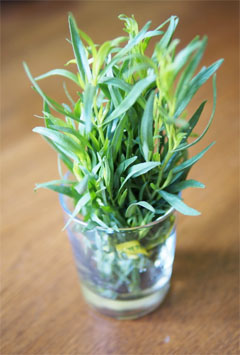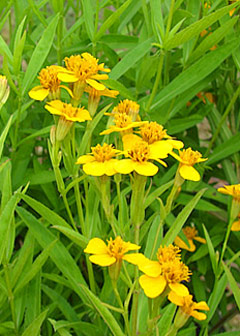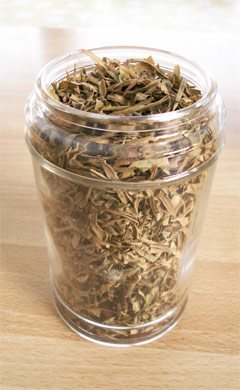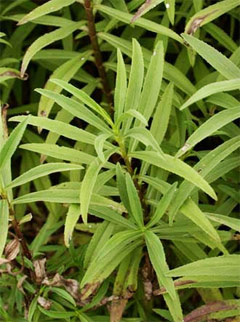|
|
Tarragon: King of herbs

Tarragon, known as the "king of herbs" in France, is widely used in a
flavoring in traditional French cooking and across the globe. Tarragon is rich
in vitamins and phytonutrients that may impart health benefits. The herb is
available fresh, dried or in capsule form at your local health food store.
Tarragon is a species of perennial herb in the family Asteraceae. One
sub-species, Artemisia dracunculus var. sativa, is cultivated for use of the
leaves as an aromatic culinary herb. In some other sub-species, the
characteristic aroma is largely absent. The species is polymorphic. Informal
names for distinguishing the variations include "French tarragon" (best for
culinary use), "Russian tarragon" (typically better than wild tarragon but not
as good as so-called French tarragon for culinary use), and "wild tarragon"
(covers various states).
Tarragon is native to soils that have relatively little water retention. But it
is not a desert plant. It is found natively in a number of areas of the Northern
Hemisphere. It grows to 120150 cm tall, with slender branched stems. The leaves
are lanceolate, 28 cm long and 210 mm broad, glossy green, with an entire
margin. The flowers are produced in small capitulae 24 mm diameter, each
capitulum containing up to 40 yellow or greenish-yellow florets.
French tarragon, however, seldom produces any flowers (or seeds). Some tarragon
plants produce seeds that are generally only sterile. Others produce viable
seeds. Tarragon has rhizomatous roots and it readily reproduces from the
rhizomes. The name "tarragon" is believed to have been borrowed from the Persian
name for tarragon which is tarkhu.
French tarragon is the variety generally considered best for the kitchen, but is
never grown from seed as the flowers are sterile, instead it is propagated by
root division. It is normally purchased as a plant, and some care must be taken
to ensure that true French tarragon is purchased. A perennial, it normally goes
dormant in winter. It likes a hot, sunny spot, without excessive watering.
Russian tarragon can be grown from seed but is much weaker in flavor when
compared to the French variety. However, Russian tarragon is a far more hardy
and vigorous plant, spreading at the roots and growing over a meter tall. This
tarragon actually prefers poor soils and happily tolerates drought and neglect.
It is not as strongly aromatic and flavorsome as its French cousin, but it
produces many more leaves from early spring onwards that are mild and good in
salads and cooked food. Russian tarragon loses what flavor it has as it ages and
is widely considered useless as a culinary herb, though it is sometimes used in
crafts.
The young stems in early spring can be cooked as an asparagus substitute.
Horticulturists recommend that Russian tarragon be grown indoors from seed and
planted out in the summer. The spreading plants can be divided easily. A better
substitute for French tarragon is Spanish tarragon, also known as Mexican mint
marigold, Mexican tarragon, Texas tarragon, or Winter tarragon. The flavor is
stronger than Russian tarragon and does not diminish significantly with age.
Though it is a member of the marigold family, the flavor is much more
reminiscent of French tarragon, with a hint of anise.
 Tarragon has an aromatic property reminiscent of anise, due to the presence of
estragole, a known carcinogen and teratogen in mice. The European Union
investigation revealed that the danger of estragole is minimal even at 1001,000
times the typical consumption seen in humans. Estragole concentration in fresh
tarragon leaves is about 2900 mg/kg. Tarragon has an aromatic property reminiscent of anise, due to the presence of
estragole, a known carcinogen and teratogen in mice. The European Union
investigation revealed that the danger of estragole is minimal even at 1001,000
times the typical consumption seen in humans. Estragole concentration in fresh
tarragon leaves is about 2900 mg/kg.
Tarragon is one of the four fines herbes of French cooking, and is particularly
suitable for chicken, fish and egg dishes. Tarragon is the main flavoring
component of B�arnaise sauce. Fresh, lightly bruised sprigs of tarragon are
steeped in vinegar to produce tarragon vinegar.
Tarragon is used to flavor a popular carbonated soft drink in the countries of
Azerbaijan, Armenia, Georgia and, by extension, Russia, Ukraine and Kazakhstan.
The drink, named Tarhun is made out of sugary tarragon concentrate and colored
bright green.
In Slovenia, tarragon is used as a spice for a traditional sweet cake called
potica. In Hungary a popular kind of chicken soup is flavored with tarragon.
Cis-Pellitorin, an isobutyramide eliciting a pungent taste, has been isolated
from Tarragon plant.
Dr. Jean Valnet, author of the reference book The Practice of Aromatherapy,
recommends to chew a tarragon leaf or to take 3 to 4 drops (adult's dose) of its
essential oil on a lump of sugar to stop hiccup.
Tarragon has a long history of use as a temporary remedy for a toothache.
According to SallyBernstein, the pain relieving effect is due to a substance
called eugenol that is also found in clove oil. The University of Arizona
Cooperative Extension adds that the pain relieving effect of tarragon can also
help decrease sore gums that can occur along with a toothache.
Tarragon also appears to have properties that may help increase appetite. A 2010
study published in "Diabetes" found that the constituents of several herbs
including tarragon were effective in increasing appetite in laboratory mice.
When used as an herb in cooking tarragon is generally considered safe; the
research suggests that adding it to food may help people with a poor appetite
due to age or illness.
Tarragon is a popular culinary herb that adds flavor to savory dishes.
Additionally, "Alternative Medicine" explains that tarragon may help calm an
upset stomach caused by stress and improve digestion. The authors recommend
using the essential oil of tarragon for calming the digestive system, along with
anise seed oil and raw honey. You can find tarragon and anise oils at your local
health food store, however, if you have an allergy to these herbs or to honey,
avoid this approach.
Tarragon, specifically the Turkish variety appears to have antioxidant
properties that can help neutralize the actions of substances known as free
radicals. Free radicals, which are the byproduct of metabolism can cause damage
to your cells if your body is not able to get rid of them efficiently as waste.
As a result, the free radicals remain in your system, causing damage that can
lead to certain types of cancer. A 2005 study published in the "Journal of
Agricultural Food Chemistry" found that tarragon oil worked as an effective free
radical scavenger. In addition, the oil was found to have both antibacterial and
antifungal properties.
 Tarragon being a rich source of Vitamin C helps boost the immune system of the
body. It helps prevent strain on the immune system, preventing a variety of
infections and ailments. Tarragon being a rich source of Vitamin C helps boost the immune system of the
body. It helps prevent strain on the immune system, preventing a variety of
infections and ailments.
Tarragon may also be deployed to cure insomnia. It helps relax the nerves and
also regulates the circulatory system. It helps cure restlessness and may be
used to induce sound sleep.
Tarragon regulates blood circulation, thereby leading to proper distribution of
nutrients and oxygen in the body.
Tarragon also helps remove toxins from the body, detoxifying the body. This
helps prevent the formation and growth of oncogens or cancer cells, thereby
preventing the grave affliction.
Being a detoxifying agent, tarragon helps reduce the pace of aging. It helps
prevent visible signs of aging like wrinkles, fine lines, patchy skin and dark
spots.
Tarragon is an anti-rheumatic substance which helps prevent and cure rheumatic
arthritis by removing toxins from the body and promoting blood circulation in
the body, including lymph.
Another health benefit of tarragon is its ability to curb the growth and
proliferation of microbes under the skin. This may be attributed to its spicy
smell and chemical composition. As such, it may be used as a deodorant.
Tarragon is a potent vermifuge, which helps eradicate round worms and tape worms
from the intestines, thereby preventing digestive ailments. It helps prevent the
loss of nutrients from the body, thereby maintaining the overall physiology.
Another health benefit of tarragon is its ability to regulate menstrual cycle,
and alleviate pre-menstrual symptoms (PMS), serving as a powerful emmenagogue.
Tarragon inhibits the activation of blood platelets, preventing the aggregation
and clinging of platelets on the walls of blood vessels, thereby preventing
heart attack and stroke.
Tarragon is anti-bacterial in action and as such, it may be applied to external
cuts and wounds to prevent septic infections.
Tarragon helps in the formation of blood pigment called hemoglobin and as such,
prevents deficiency of red blood cells or anemia.
Tarragon being a rich source of zinc helps in protein synthesis, thereby
regulating the formation of cellular structures of the body.
Another vital health benefit of tarragon is its ability to promote the state of
the thyroid gland, attributed to its rich copper content. It helps protect the
nervous system by preserving the myelin sheaths of nerves.
 Being a rich source of calcium, tarragon helps maintain the health of skeletal
system by strengthening bones. Being a rich source of calcium, tarragon helps maintain the health of skeletal
system by strengthening bones.
Tarragon promotes cholesterol metabolism by promoting the secretion of essential
digestion co-factors, attributed to its manganese content. As such, tarragon
prevents the susceptibility of arteriosclerosis and other cardiovascular
diseases.
Tarragon also helps enhance vision, hair and skin texture.
Tarragon should not be consumed during the pregnancy period as some of the
chemical components of tarragon like methyl chavicol may adversely affect the
health of the mother and the baby. Some of the known tarragon supplements are
wormwood, mugwort and sagebrush.
The health benefits of tarragon tea include its ability to relieve depression
and anxiety. It also helps relieve fatigue, and induces a feeling of well being.
Tarragon is generally reported to have positive effects on health, with no side
effects. However, some people may be allergic to the herb, and as such, refrain
from its usage as herb, tea or essential oil.
Tarragon is a rich source of phyto-nutrients, which imparts numerous health
benefits.
Some of the chemical substances in the tarragon essential oil are methyl
chavicol, ocimene, phellandrene and cineol. Tarragon is also a rich source of
certain vital vitamins including Vitamin A, Vitamin B-complex and Vitamin C.
Terragon is a rich source of certain essential minerals including zinc, calcium,
manganese, iron, magnesium, potassium and copper, among others. Tarragon may be
used as tea, dried leaves, fresh leaves, tincture, infusion and essential oil.
Video
Dated 31 October 2013
|
|
|
|
|









